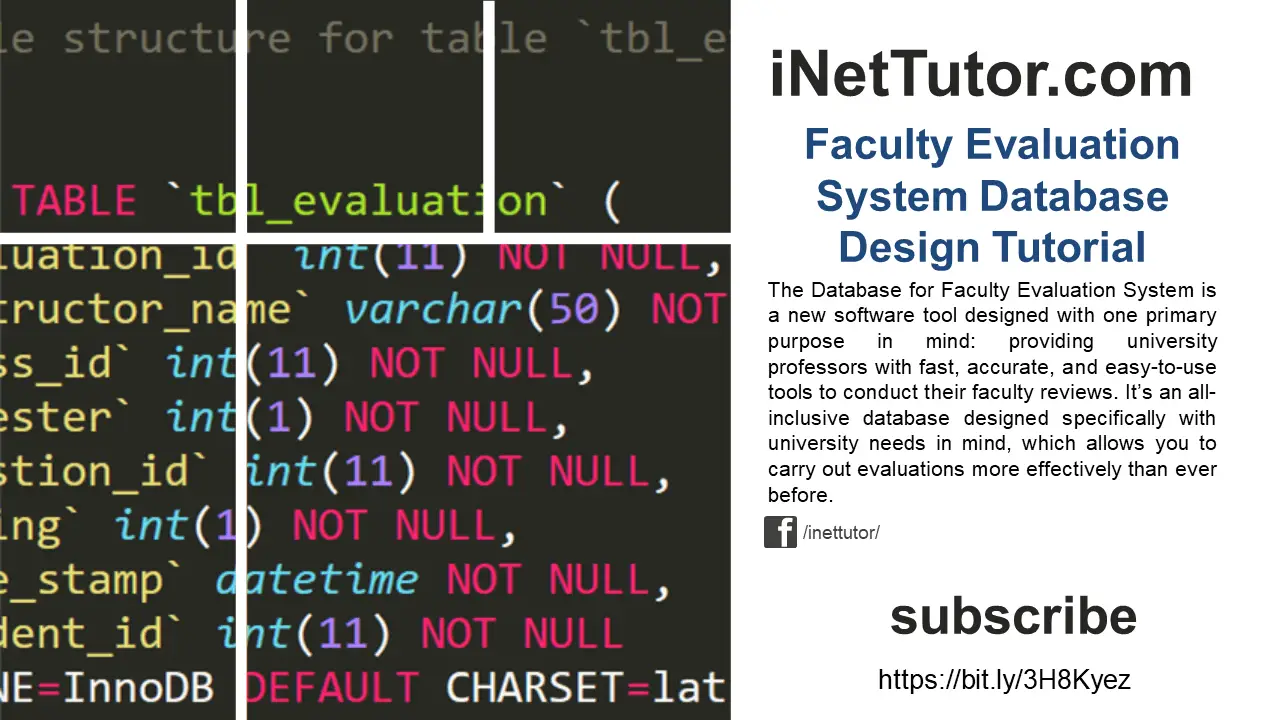Faculty Evaluation System Database Design Tutorial
Introduction
Table of Contents
A large number of universities are looking for ways to improve the techniques of evaluation that they employ. A new system has been developed that faculty evaluation system owners can use to help them do these evaluations. This content will provide information about the initial stage on the development of the faculty evaluation system and that is the database design.
Database for Faculty Evaluation System – The Database for Faculty Evaluation System is a new software tool designed with one primary purpose in mind: providing university professors with fast, accurate, and easy-to-use tools to conduct their faculty reviews. It’s an all-inclusive database designed specifically with university needs in mind, which allows you to carry out evaluations more effectively than ever before.
In this article/video tutorial, we will discuss the database design of a Faculty Evaluation System. The team can design and develop the said project in PHP and MySQL in order to handle a large number of evaluations.
Let’s get started with creating the tables and their columns. Please watch the video for a more in-depth demonstration.

Faculty Evaluation System Database Design Tutorial – List of Tables
tbl_student_profile – this table store the students’ profile in the system.
- student_id – primary key of the table. It is set usually to auto_increment (the database will automatically give this column a value starting from 1).
- complete_name – the complete name of the student
- id_number – unique id number assigned for a specific student
- class_id – class where the student belong to
Create SQL Statement – the statement below is used to create the tbl_student_profile, copy the sql statement and paste it in the sql manager/tab of your phpmyadmin.
CREATE TABLE `tbl_student_profile` ( `student_id` int(11) NOT NULL, `complete_name` varchar(100) NOT NULL, `id_number` varchar(15) NOT NULL, `class_id` int(11) NOT NULL ) ENGINE=InnoDB DEFAULT CHARSET=latin1;
tbl_class_management – the class information are reflected and stored in this table.
- class_id – primary key of the table. It is set usually to auto_increment (the database will automatically give this column a value starting from 1).
- class_code – this is a unique code assigned to a specific class
- instructor_name – the name of the instructor
- subject – the name of the subject
- schedule – the class schedule
- no_of_students – total number of students in the class
Create SQL Statement – the statement below is used to create the tbl_class_management, copy the sql statement and paste it in the sql manager/tab of your phpmyadmin.
CREATE TABLE `tbl_class_management` ( `class_id` int(11) NOT NULL, `class_code` varchar(10) NOT NULL, `instructor_name` varchar(100) NOT NULL, `subject` varchar(30) NOT NULL, `schedule` time NOT NULL, `no_of_students` int(2) NOT NULL ) ENGINE=InnoDB DEFAULT CHARSET=latin1;
tbl_question_category – this table store the information of question category in the system.
- category_id – primary key of the table. It is set usually to auto_increment (the database will automatically give this column a value starting from 1).
- category_name – the name of the question’s category
- description – description of the question category
Create SQL Statement – the statement below is used to create the tbl_question_category, copy the sql statement and paste it in the sql manager/tab of your phpmyadmin.
CREATE TABLE `tbl_question_category` ( `category_id` int(11) NOT NULL, `category_name` varchar(30) NOT NULL, `description` varchar(50) NOT NULL ) ENGINE=InnoDB DEFAULT CHARSET=latin1;
tbl_question – the details of the question in the system are stored in this table.
- question_id – primary key of the table. It is set usually to auto_increment (the database will automatically give this column a value starting from 1).
- category_id – this is a foreign key that points out to the category name of the question
- question – the actual question
Create SQL Statement – the statement below is used to create the tbl_question, copy the sql statement and paste it in the sql manager/tab of your phpmyadmin.
CREATE TABLE `tbl_question` ( `question_id` int(11) NOT NULL, `category_id` int(11) NOT NULL, `question` varchar(200) NOT NULL ) ENGINE=InnoDB DEFAULT CHARSET=latin1;
tbl_evaluation – the details of the evaluation done using the system are reflected and held in this table.
- evaluation_id
- instructor_name – the name of the instructor
- class_id – this is a foreign key that points out to the class under a specifc instructor
- semester – the current semester (ex. First semester)
- question_id – this is a foreign key that points out to the question
- rating – the rating yield from the evaluation
- time_stamp – the exact time when the evaluation was done
- student_id – this is a foreign key that points out to the student
Create SQL Statement – the statement below is used to create the tbl_evaluation, copy the sql statement and paste it in the sql manager/tab of your phpmyadmin.
CREATE TABLE `tbl_evaluation` ( `evaluation_id` int(11) NOT NULL, `instructor_name` varchar(50) NOT NULL, `class_id` int(11) NOT NULL, `semester` int(1) NOT NULL, `question_id` int(11) NOT NULL, `rating` int(1) NOT NULL, `time_stamp` datetime NOT NULL, `student_id` int(11) NOT NULL ) ENGINE=InnoDB DEFAULT CHARSET=latin1;
tbl_comments – this table store the information of the comments made using the system.
- comment_id – primary key of the table. It is set usually to auto_increment (the database will automatically give this column a value starting from 1).
- instructor_name – the name of the instructor
- comments – the comments of the instructor
- student_id – this is a foreign key that points out to the student
- semester – the current semester
- time_stamp – the specific time the comment was made
Create SQL Statement – the statement below is used to create the tbl_comments, copy the sql statement and paste it in the sql manager/tab of your phpmyadmin.
CREATE TABLE `tbl_comments` ( `comment_id` int(11) NOT NULL, `instructor_name` varchar(100) NOT NULL, `comments` varchar(200) NOT NULL, `student_id` int(11) NOT NULL, `semester` int(1) NOT NULL, `time_stamp` datetime NOT NULL ) ENGINE=InnoDB DEFAULT CHARSET=latin1;
tbl_user_management – this table store the details of users of the system.
- user_id-primary key of the table. It is set usually to auto_increment (the database will automatically give this column a value starting from 1).
- complete_name – complete name of the user
- designation – the name of the user’s designation
- username – the desired username of the user combined with the password to access the system.
- password
Create SQL Statement – the statement below is used to create the tbl_user_management, copy the sql statement and paste it in the sql manager/tab of your phpmyadmin.
CREATE TABLE `tbl_user_management` ( `user_id` int(11) NOT NULL, `complete_name` varchar(100) NOT NULL, `designation` varchar(30) NOT NULL, `username` varchar(15) NOT NULL, `password` text NOT NULL ) ENGINE=InnoDB DEFAULT CHARSET=latin1;

Indexes for dumped tables
-- -- Indexes for table `tbl_class_management` -- ALTER TABLE `tbl_class_management` ADD PRIMARY KEY (`class_id`); -- -- Indexes for table `tbl_comments` -- ALTER TABLE `tbl_comments` ADD PRIMARY KEY (`comment_id`), ADD KEY `student_id` (`student_id`); -- -- Indexes for table `tbl_evaluation` -- ALTER TABLE `tbl_evaluation` ADD PRIMARY KEY (`evaluation_id`), ADD KEY `class_id` (`class_id`), ADD KEY `question_id` (`question_id`), ADD KEY `student_id` (`student_id`); -- -- Indexes for table `tbl_question` -- ALTER TABLE `tbl_question` ADD PRIMARY KEY (`question_id`), ADD KEY `category_id` (`category_id`); -- -- Indexes for table `tbl_question_category` -- ALTER TABLE `tbl_question_category` ADD PRIMARY KEY (`category_id`); -- -- Indexes for table `tbl_student_profile` -- ALTER TABLE `tbl_student_profile` ADD PRIMARY KEY (`student_id`), ADD KEY `class_id` (`class_id`); -- -- Indexes for table `tbl_user_management` -- ALTER TABLE `tbl_user_management` ADD PRIMARY KEY (`user_id`), ADD UNIQUE KEY `username` (`username`); -- -- AUTO_INCREMENT for dumped tables -- -- -- AUTO_INCREMENT for table `tbl_class_management` -- ALTER TABLE `tbl_class_management` MODIFY `class_id` int(11) NOT NULL AUTO_INCREMENT; -- -- AUTO_INCREMENT for table `tbl_comments` -- ALTER TABLE `tbl_comments` MODIFY `comment_id` int(11) NOT NULL AUTO_INCREMENT; -- -- AUTO_INCREMENT for table `tbl_evaluation` -- ALTER TABLE `tbl_evaluation` MODIFY `evaluation_id` int(11) NOT NULL AUTO_INCREMENT; -- -- AUTO_INCREMENT for table `tbl_question` -- ALTER TABLE `tbl_question` MODIFY `question_id` int(11) NOT NULL AUTO_INCREMENT; -- -- AUTO_INCREMENT for table `tbl_question_category` -- ALTER TABLE `tbl_question_category` MODIFY `category_id` int(11) NOT NULL AUTO_INCREMENT; -- -- AUTO_INCREMENT for table `tbl_student_profile` -- ALTER TABLE `tbl_student_profile` MODIFY `student_id` int(11) NOT NULL AUTO_INCREMENT; -- -- AUTO_INCREMENT for table `tbl_user_management` -- ALTER TABLE `tbl_user_management` MODIFY `user_id` int(11) NOT NULL AUTO_INCREMENT;
Summary
College students often have to take some sort of course evaluation for their professors. These typically take the form of a survey, essay, or comment box on which you can write any feedback you’d like. However, some colleges are using new platforms to allow students to better evaluate professors in an online format.
Faculty Evaluation System (FES) is a database-driven system that will automate the processes in conducting faculty evaluation. The Faculty Evaluation System is designed to be an interactive and computational work environment that can assist administrators and faculty members handle faculty evaluation concerns more smoothly and efficiently.
Creating a normalized database design is very important in the development of Faculty Evaluation System and we hope that you have learned something from this tutorial.
You may visit our Facebook page for more information, inquiries, and comments. Please subscribe also to our YouTube Channel to receive free capstone projects resources and computer programming tutorials.
Hire our team to do the project.
Related links:
Blood Bank Information System Database Design
Lost and Found Information System Database Design
Daily Time Record System Database Design
Dairy Farm Management System Database Design
